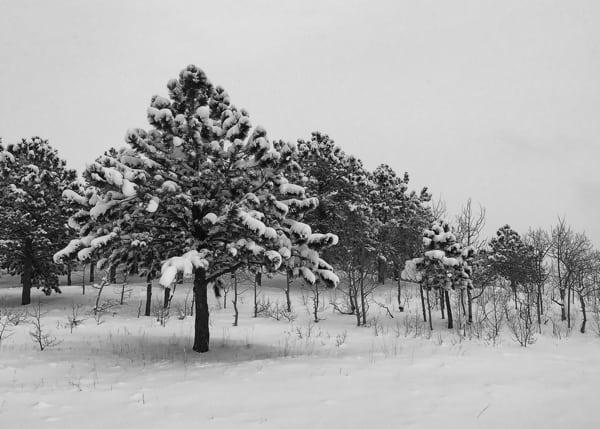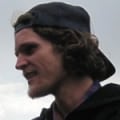Winter seems finally to have arrived in Colorado. The first light reveals a dusting of snow on the ground, a couple of inches at most, a lot less than the forecasted foot and a half of accumulation. It is hard to blame the weatherman for such inaccuracies as the climate these days, more so than ever, has a mind of its own. I drive cautiously down Sunshine Canyon on my way to pick up Tony. Below the light layer of white puff is a sheet of ice making the downhill and steep turns particularly tricky. I have run this road, in these conditions, countless times and even with adequate traction, it is an awkward, precarious endeavour.
Several years back, I resigned myself to not desperately trying to run at all costs throughout the winter and resolved instead to utilize better tools to navigate the snow-covered peaks. The most cost-effective solution is a pair of running snowshoes that serves my purposes well in being physically engaging, practical in all types of mixed terrain and also low impact on the body. While fun, snowshoeing does lack a little something to make it a completely fulfilling winter activity. Perhaps it is the fact that even in good conditions an unreasonable amount of effort is required to cover only a small amount of terrain. I knew there must be a better way and that is when I turned to skiing.
I used to snowboard in my early twenties and while I certainly had no expectations for skiing meeting the feel of carving and flow only a board can provide, it certainly had a more utilitarian appeal that is also applicable to running.
The two biggest obstacles to getting into ski mountaineering are the cost of lightweight gear and the availability of good uphill access in close proximity to home. With a pair of budget race skis costing upwards of $600, buying a full setup is a committed purchase and one that you definitely do not want just sitting in the garage. It took me several years to cobble together decent kit that suits my purposes of moving light and fast in the mountains.
Tony has taken a similar approach to mine and now that we are both all geared up, we have set out to find good spots for condensed, high-vertical accumulation and quality, downhill turns. Several of these places exist along the Peak to Peak highway, which travels south to north from Central City to Estes Park, keeping access at under an hour from Boulder. I will remain purposefully vague about the location described henceforth, not because I feel personally protective, but some people do and part of the fun and complexity of skiing is the search for those hidden gems.
As Tony and I start up the hill, the air is thick and humid, the light snowfall misty and wet, leaving us both drenched within a few minutes. The uphill glide is surprisingly good, making it easy to engage in a swift rhythm. There is something very peaceful about ski travel, the loudest noises coming from our breathing and the creaking of our boots. The track ahead offers a couple of thousand feet of vertical gain at a near perfect skinning grade. While the tunnel of trees could appear monotonous, I take pleasure in finding each little cut and turn that offers the best line up the hill. Once we gain the ridge, a sip of water and then a quick transition into downhill mode opens up a new world of fun. The snow is fantastic today with a solid base and several inches of fresh powder on top. There is just enough fluff for our skinny race skis to float. Each turn has a bouncy pop, controlled with the slightest digging in of the heels. We dart through the trees, quads burning ferociously for 10 to 15 minutes of exhilaration. Another quick transition and then repeat–back to the uphill shuffle.
On the second lap, we pass three guys on a quad with caterpillar tread. They pack the track in nicely on their machine, stopping frequently for booze, cigs, and weed. At the top of the climb, they take turns ripping inspired lines on a snowboard.
Tony and I enjoy slightly different parts of the mountain so while he is off on his own, I stop to chat with an older guy making his way up the hill, who introduces himself as Bill. He is sporting a Colorado ball cap, a large pack, and some vintage backcountry Nordic setup.
“You guys come up here quite a bit, don’t you?” he asks.
“Yeah, it’s a nice place close to town to get some vertical in and some good turns,” I reply.
“I’ve been skiing here for 30 years,” Bill continues, “so I get a little possessive of the place.”
He drills me with a few questions, asks me about my “buddy,” with a reserved, suspicious tone, but not unfriendly. He then adds:
“When I encounter people like yourself who have a good attitude and that clearly love it up here, I might be inclined to open up… you know, share a few secrets about the good lines… most people come up here and get one lap in, but you guys get four or five in so you may as well be skiing the good stuff…”
For the next few laps, I take him up on his suggestions, gaining great satisfaction in the newfound knowledge and developing a growing intimacy with the place.
It is snowing harder now and the texture of the track has changed to a sticky styrofoam, slowing the descent and forcing us to skate the final mile back to the truck. Skiing is tremendously engaging physically, but also has wonderful complexity that pushes us to better read and understand the terrain we travel. As such, it is a complete activity, fulfilling on many levels and one I hope to keep pursuing much like Bill for years to come.
Call for Comments (from Meghan)
- Do you ski in the winter? If so, what sort of skiing do you do?
- Or, do you turn your athletic inclinations into another sport, in another season? What sport is that?
- What parallels do you draw between running and the other sports you engage in? Or, do the other sports engage you in an entirely different manner from running?






